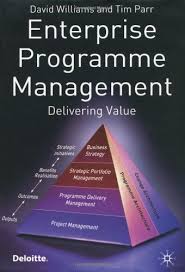Premise:
The premise of "Enterprise Programme Management" is to provide guidelines, best practices and new techniques to enhance an organization’s credibility in leading multiple projects as a single body of work. Program Management requires the integration of delivering milestones, products, solutions and critical capabilities. The book advocates building a core capability around program management and linking strategy to the overall program and managing an organization’s limited resources across the program life cycle. The enterprise program management approach requires organizations to focus on managing components such as risk management, benefits management, benefits realization, allocation of resources and sourcing strategies suppliers. These items are critical to the success of all programs that requires the synchronization of multiple projects using limited resources to deliver future capabilities across the company.
What I learned:
- Organizational agility can be developed through enterprise programme management practices. It will help executives identify and deliver change throughout the organization in a more nimble manner by being able to clearly articulate what change looks like and to deliver the change in a timely manner to meet market demands.
- One of the tenants of program management is the ability to deliver projects within a program in a coordinated and efficient manner. This requires the consistent application of people, processes, tools, and methodologies in a manner that delivers consistent results and outcomes.
- The Program architecture should also be consider when developing an enterprise program management practice. Program architecture consists of the development of key leadership teams and structures that clearly articulate a team’s values and behaviors.
- Implementing a Program Governance framework is also critical to enable the consistent delivery of program artifacts and outcomes.
- A key result of program management is the delivery of program benefits. Program benefits are the key goals and outcomes the business has targeted to achieve. The initiation of a collection of multiple projects managed as a single unit should deliver the core benefits that the organization has invested in and is expecting the program to provide.
- Benefits management is a key element of enterprise program change management, and it identifies, tracks and communicates the expected change benefits in a way that illustrates the achievement of the required benefits while also minimizes the negative impact of implementing the request of benefits.
- One of the key insights I gleaned from the book was the Change Journey Map Diagram. The Change Journey Map is a Gantt chart diagram that illustrates the elements of change required to implement the program’s projects in a way that delivers the required benefits and enables the organization to adapt and adopt the changes to take advantage of those benefits.
Conclusion:
In conclusion, "Enterprise Programme Management" provides guidelines, procedures, best practices and processes that you can adopt in the development of your program management practice. There is a enterprise program management capability check list and assessment guide at the end of the book. This assessment enables you to take what you've learned from the book and identify areas of strength and weakness in your organizations. It also provides recommendations that you can put into practice immediately to build a more robust enterprise program management practice in your organization.

